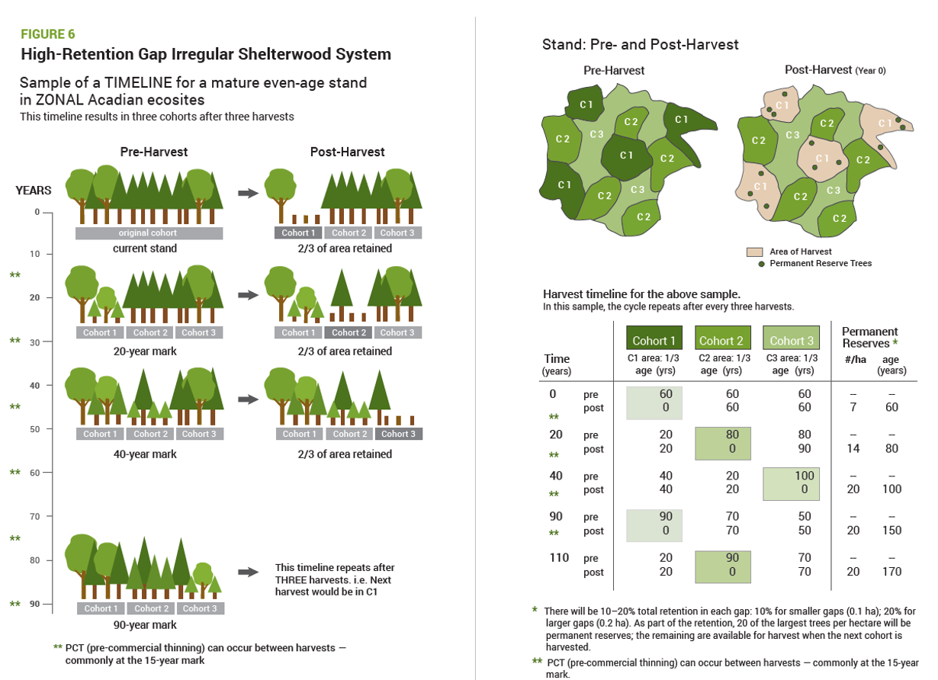
Forest Management Guide: public consultation
Nova Scotians were invited to provide their feedback on the new Forest Management Guide, which outlines the silviculture prescriptions and timber harvest methods allowed on Crown land. Consultations closed on 19 February 2021.
Government is committed to adopting ecological forestry in Nova Scotia. Work is underway to move to a triad model of ecological forestry for how we manage our Crown land forests.
New Draft Forest Management Guide
The new draft guide, called Silvicultural Guide for the Ecological Matrix (SGEM), incorporates feedback from stakeholder consultations that happened in August 2019 and March 2020. It includes feedback from industry, environmental groups, private landowners, forest professionals, and the Mi’kmaq, and input from the Ministerial Advisory Committee.
Read a summary of stakeholder feedback part 1 (Feb. 2020) and part 2 (Dec. 2020) received and how we’re addressing their input in the draft guide (Silvicultural Guide for the Ecological Matrix).
Ecological forestry model
The new draft guide is an important part of the ecological forestry model. The triad model for ecological forestry is made up of 3 zones that work together: production forest zones, conservation zones and ecological matrix zones.
The new draft guide includes changes to how Crown land forests would be managed in the province in mixed-use areas (the ecological matrix zone of the triad). The ecological matrix zone is designed to work in concert with high production forestry zones and conservation zones, making up a triad that prioritizes biodiversity across Crown land forests. It is important to note that legislation, policies and procedures that protect Species at Risk and their designated core habitat will continue to apply in all legs of the triad.
Learn more: Ecological forestry | Understanding ecological forestry
Changes from the previous Forest Management Guide
Important highlights and changes from the previous guide include:
- prioritizing biodiversity by:
- producing more diverse forests in terms of age, structure and tree species
- enhancing the requirement to capture and report biodiversity data during pre-treatment assessments
- shifting towards creation, enhancement and maintenance of diverse multi-aged forests
- considering natural disturbances in management decisions by:
- designing silvicultural approaches that first consider unique ecological climate conditions
- aligning tree retention levels and silvicultural approaches to match conditions like those resulting from natural disturbances (like wind, fire and pests)
- greatly reducing clearcutting in the mixed-use ecological matrix zone by:
- promoting and encouraging multi-aged forests in the majority of harvests across the Acadian forests
- removing certain avenues for harvests, including overstory removal, seed tree and salvage
- increasing minimum retention (how many trees must remain after a harvest) from 2% to 20% to 30% in the Acadian forests, with most harvests expected to retain 40% to 70%
This figure from the SGEM illustrates a typical example how forests will grow and be harvested under the new draft guide on Crown land in the ecological matrix zone.

On the left, it shows how selective harvests, spaced out over time, will eventually lead to forests with a mix of ages that more accurately reflects the effects of natural disturbances. On the right, this diagram shows a similar stand of trees, but from above, to illustrate the how selective harvests will result in uneven-aged forests through the years, with permanent reserve trees left behind in each stand to continue to grow across decades.
What is not included in the guide
The SGEM is the technical guide used by forestry professionals in the field outlining the allowable silviculture prescriptions and timber harvest methods on the ground in the matrix areas of the triad model on Crown land.
As such, it does not cover aspects related to the other two legs of the triad model - the high production forestry and conservations zones. In addition, it does not cover other aspects of the Lahey review of forestry practices recommendations in areas such as: old forest policy, species at risk program renewal, small scale wood energy, etc. (visit https://novascotia.ca/ecological-forestry/ for more details).
One important change from the previous version of the guide includes temporarily separating out the Maritime Boreal forest. The Maritime Boreal represents around 13% of the province’s forested Crown Land, and has unique characteristics including species composition, climate and natural disturbance primary agents and effects.
Work to determine how best to apply ecological forestry practices to our Maritime Boreal forests is continuing while allowing work on the rest of the guide to proceed. The department plans to consult on proposed changes to forest management in the Maritime Boreal forest.
Next steps
The Department of Natural Resources and Renewables will review and consider all feedback from the consultation and update the draft guide for the Acadian forest types as appropriate.
The department will also conduct a separate consultation on proposed harvesting practices in the Maritime Boreal forest.
From there, the department will work closely with silvicultural practitioners on training and implementation of the new draft guide.